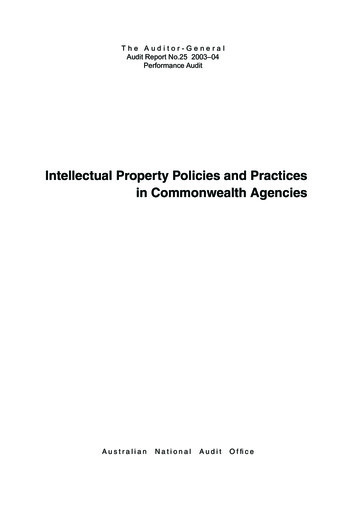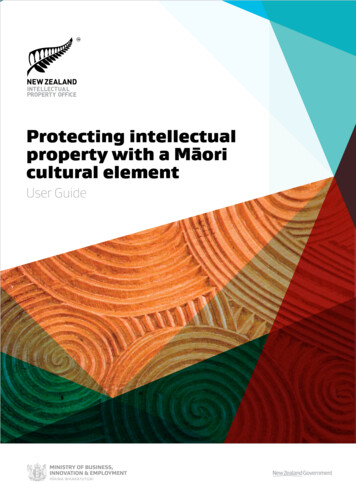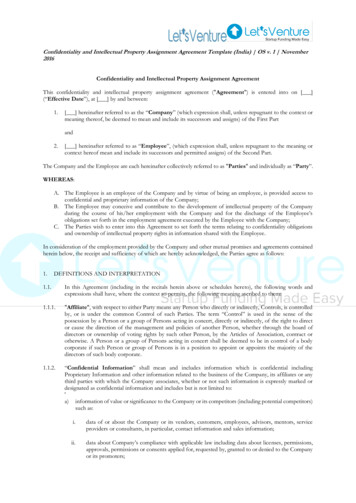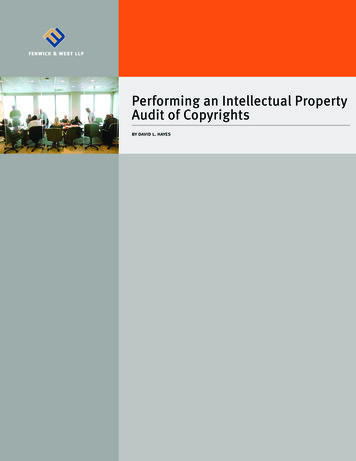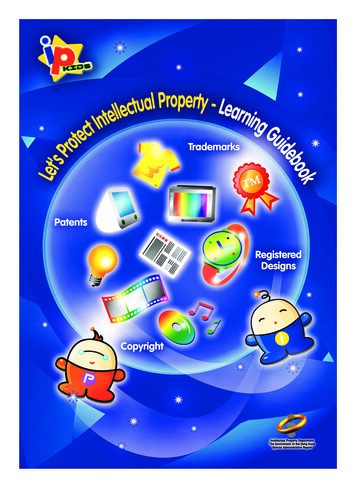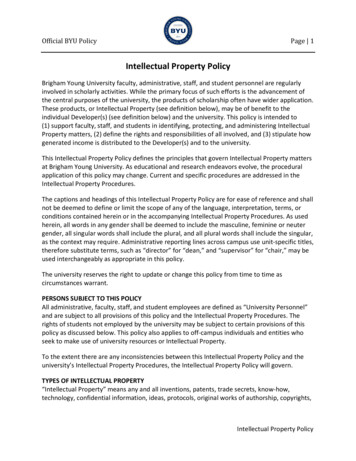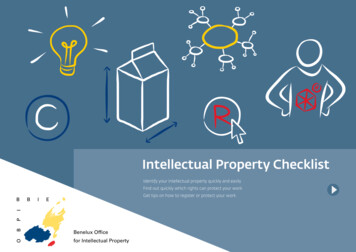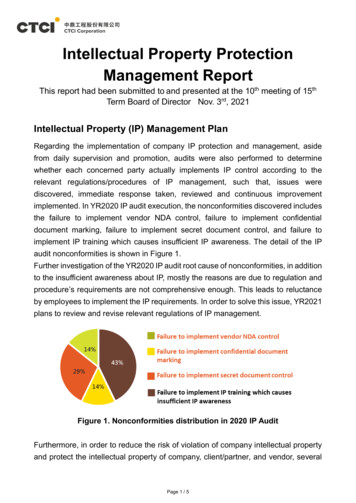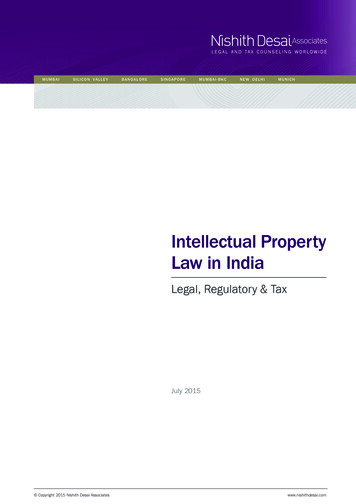
Transcription
Intellectual PropertyRights - AccountingaspectsPresented by: CA Vijay Mathur10 August 2013
Agenda Intellectual Property Rights (IPR) - some definitions IPR accounting – relevance and challenges Accounting aspects – issues and considerations Accounting Standards dealing with IPR What are Intangible assets? Recognition of Intangibles Research and Development Amortisation and useful life Impairment2
IPR – DefinitionAs per World Trade OrganisationIntellectual Property Rights (IPR) are the rights given to persons over the creations of their minds.They usually give the creator an exclusive right over the use of his/her creation for a certainperiod of timeIIICopyright and rights related to copyright The rights of authors of literary and artistic works (such as books and other writings, musicalcompositions, paintings, sculpture, computer programs and films) are protected by copyright,for a minimum period of 50 years after the death of the author Also protected through copyright and related (sometimes referred to as “neighbouring”) rightsare the rights of performers (e.g. actors, singers and musicians), producers of phonograms(sound recordings) and broadcasting organizations. The main social purpose of protection ofcopyright and related rights is to encourage and reward creative workIndustrial property One area can be characterized as the protection of distinctive signs, in particular trademarks(which distinguish the goods or services of one undertaking from those of other undertakings)and geographical indications (which identify a good as originating in a place where a givencharacteristic of the good is essentially attributable to its geographical origin) Other types of industrial property are protected primarily to stimulate innovation, design andthe creation of technology. In this category fall inventions (protected by patents), industrialdesigns and trade secrets3
IPR – Definition(Continued)As per Development Commissioner - Micro, Small and Medium EnterprisesIntellectual Property Rights (IPR) are legal rights, which result from intellectual activity inindustrial, scientific, literary & artistic fields. These rights safeguard creators and otherproducers of intellectual goods & services by granting them certain time-limited rightsto control their use. Protected IP rights like other property can be a matter of trade,which can be owned, sold or boughtTypes of IPRa. Patentsb. Trademarks/ Brandsc. Copyrights and related rightsd. Geographical Indicationse. Industrial Designsf.Trade Secretsg. Layout Design for Integrated Circuitsh. Protection of New Plant Variety4
IPR accounting – relevance and challenges As corporations around the world are awakening to the revenue-generatingpotential of intangible assets, the issue of accounting for intellectualproperty gains importance Varying accounting practices are prevalent resulting in differing Balancesheets and Profit and loss accounts Due to absence of organised and transparent markets, and subjectivityinvolved, there are difficulties in determining value of IPRs Accounting rules are evolving to enhance reporting/disclosures of IPR Gaps exist between the economic framework of accounting, which attemptsto record Intangibles as assets, and legal frameworks that record IPR - thisleads to disparity between what companies show in the balance sheet andwhat companies actually own Is IP Report a need of the hour (in case of internally generated IPs)?5
IPR accounting – relevance and challenges(Continued)IPRs recorded on the balance sheets can be significant . Pepsi has perpetual brands of USD 4,839 million representing 6% of its totalassets Walt Disney has copyrights and trademarks aggregating USD 4,273 millionrepresenting 6% of its total assets Microsoft has technology based and marketing related intangibles of USD3,083 million representing 2% of its total assets Coca Cola has perpetual trademarks of USD 6,527 million representing 8%of its total assets Google has patents and developed technology of USD 5,987 millionrepresenting 6% of its total assets6
Accounting aspects – issues and considerations Identifiability – nature? Control – ownership /title Economic benefits At cost / fair value / market value / Revaluation ? Valuation techniques --- (subjective) Purchased / internally generated Capitalise / expense (Research v/s Development) Subsequent costs Amortisation Impairment7
Applicability of accounting literature for IPR Under Indian GAAP, accounting for IPR is guided by:-Accounting Standard 26 ‘Intangible Assets’Accounting Standard 10 ‘Fixed assets’ – As per AS 10, assets are grouped into various categories, such asland, buildings, plant and machinery, vehicles, furniture and fittings,goodwill, patents, trade marks and designs Accounting Standard 14 ‘Accounting for Amalgamations’ Typical industries with IPRs-Technology - Microsoft, IBM, Google, WiproPharma - Ranbaxy, PfizerMedia and Entertainment – Time Warner, Walt DisneyManufacturing - Pepsi, Coca Cola, Nokia8
What is an ‘Intangible Asset’ As per AS 26 ‘Intangible asset’ is– an identifiable non-monetary asset– without physical substance– held for use (a) in the production or supply of goods or services, (b) forrental to others, or (c ) for administrative purposes An asset is– a resource controlled by an enterprise– from which future economic benefits are expected to flow to theenterprise9
What is an ‘Intangible Asset’(Continued) AS 26 applies to expenditure on advertising, training, start-up, researchand development activities, rights under licensing agreements (for itemssuch as motion picture films, video recordings, plays, manuscripts) AS 26 also covers intangible resources such as scientific or technicalknowledge, design and implementation of new processes or systems,licences, intellectual property, market knowledge and trademarks (includingbrand names and publishing titles). Common examples of itemsencompassed by these broad headings are computer software, patents,copyrights, motion picture films, customer lists, mortgage servicing rights,fishing licences, import quotas, franchises, customer or supplierrelationships, customer loyalty, market share and marketing rights Not all the items described above will meet the definition of an intangibleasset AS 26 does not apply to certain items10
Criteria Identifiability Control Future economic benefits11
Identifiability Clearly distinguished from goodwill – is separable Enterprise can rent/sell/exchange/distribute future benefits Asset is identifiable even if it generates future benefits in combinationwith other assets12
Control Power to obtain future benefits Also can restrict access of others to those benefits Normally stems from legal rights enforceable in a court of law In absence of legal rights, more difficult to demonstrate control13
Future economic benefits Revenue Cost savings Other benefits from the use of asset An intangible asset can be recognised if, and only if: it is probable that the future economic benefits that are attributable to theasset will flow to the enterprise; and the cost of the asset can be measured reliably14
Recognition of intangible assets An intangible asset should be measured initially at cost. After initialrecognition, an intangible asset should be carried at its cost less anyaccumulated amortisation and any accumulated impairment losses. Per AS 10 (para 15.3) - where several assets are purchased for aconsolidated price, the consideration is apportioned to the various assets ona fair basis as determined by competent valuers (eg. Assets/businesspurchase on ‘Slump’ basis) As per AS 26 (para 27), an intangible asset acquired in an amalgamation inthe nature of purchase is accounted for in accordance with AccountingStandard 14 Indian GAAP / US GAAP does not permit Revaluation of Intangibles; underIFRS, intangibles which have an active market (eg. Emission allowance)may be revalued to fair value15
Internally generated assets Internally generated goodwill not to be recognised as an asset Internally generated brands, mastheads, publishing titles, customer lists,etc. not to be recognised as intangible assets For other internally generated assets, generation of asset to be classifiedinto (a) Research phase and (b) Development phase Costs to exclude Selling, administrative, other general overheads unlessthey can be directly attributed to making the (intangible) asset ready for use Eg. Software company - Internally generated intangible assets, excludingcapitalized development costs, are not capitalized and expenditure isreflected in the statement of profit and loss in the year in which theexpenditure is incurred16
Research phase Examples of research phase activities Activities aimed at obtaining new knowledge Search for, evaluation and final selection of, applications of researchfindings or other knowledge Search for alternatives for materials, devices, products, processes,systems or services Formulation, design, evaluation and final selection of possiblealternatives for new or improved materials, devices, products,processes, systems or services Research phase costs to be expensed in all cases17
Development phaseExamples of development phase activities: Design, construction and testing of pre-production or pre-use prototypesand models Design of tools, jigs, moulds and dies involving new technology Design, construction and operation of a pilot plant that is not of a scaleeconomically feasible for commercial production Design, construction and testing of a chosen alternative for new or improvedmaterials, devices, products, processes, systems or services18
(Continued)Development phase An intangible asset shoulddemonstrate the following:berecognisedifenterprisecan Technical feasibility of completing the asset Its intention to complete the asset and use/sell it Its ability to use or sell the intangible asset How the asset will generate probable future economic benefits Availability of adequate technical, financial and other resources tocomplete the development and to use or sell the intangible asset and Iits ability to measure the expenditure attributable to the intangible assetduring its development reliably Cost of internally generated intangible asset comprises expenditureincurred from the time when it first meets the recognition criteria19
Recognition as expense Expenditure on an intangible item to be expensed when incurredunless: it forms part of the cost of an intangible asset that meets the recognitioncriteria or the item is acquired in an amalgamation in the nature of purchase andcannot be recognised as an intangible asset. In this case, theexpenditure (included in the cost of acquisition) should form part ofgoodwill/capital reserve20
Examples of expenditure to be expensed Research Training activities / team of skilled staff Advertising/promotional activities (eg. Cost of websites developed foradvertising/promotional purposes) Portfolio of customers, market shares, customer relationships,customer loyalty Relocation/re-organisation Expenditure initially recognised as expense in previous annual/interimfinancial reports cannot later be recognised as part of cost of anintangible asset21
Subsequent expenditure To be expensed unless it is probable that the expenditure will result in future economic benefitsin excess of its originally assessed standard of performance and the expenditure can be measured and attributed to the asset reliably Only rarely will subsequent expenditure be added to the cost of theintangible asset (eg. In case of acquired in-process R& D projects)22
Amortisation Depreciable amount to be amortised over useful life Amortisation should commence when the asset is available for use23
Amortisation - method(Continued) Should reflect the pattern in which the asset's economic benefits areconsumedWDV If that pattern cannot be determined reliably, straight-line methodshould be usedSLM There will rarely, if ever, be persuasive evidence to support anamortisation method that results in a lower amount of accumulatedamortisation than under straight-line methodUOP Eg. Extractive industry - Costs incurred to gain access to mineral reservesare capitalised and amortised over the life of the quarry, which is based onthe estimated tonnes of raw materials to be extracted from the reservesEg. Pharma - Intangible assets comprise patents, trademarks, designs andlicenses and computer software which are stated at cost less accumulatedamortization (determined on a straight line basis) and impairment losses, ifany24
Useful life Rebuttable presumption that the useful life of an intangible asset willnot exceed ten years. Reasons for taking useful life exceeding tenyears to be disclosed highlighting the factors that played a significantrole in determining useful life Eg. Consumer goods - For various brands acquired by the Company,estimated useful life has been determined ranging between 20 to 25 years.The Company believes this based on number of factors including thecompetitive environment, market share, brand history, product life cycles,operating plan, no restrictions on title and the macroeconomic environmentof the countries in which the brands operate. Accordingly, such intangibleassets are being amortised over the determined useful life.25
Useful life (Continued)Computer software and many other intangible assets are susceptibleto technological obsolescence and their useful life is thus likely to beshort Eg. Mfg co. Expenditure on computer software is amortised on straightline method over the period of expected benefit not exceeding five years If control is achieved through legal rights granted for limited period,useful life not to exceed the period of the legal rights unless: the legal rights are renewable and renewal is virtually certainEg. Mfg co. - Licenses for Technical know-how have been amortised on astraight line basis over the License term of forty two monthsEg. Telecom - Bandwidth / Fibre taken on Indefeasible Right of Use (IRU)is amortised over twenty years being the agreement period Under International GAAP (IFRS/US GAAP), Intangibles can also haveindefinite useful life (eg Brands)26
Residual value In determining depreciable amount, residual value should be assumedto be zero unless: there is a commitment by a third party to purchase the asset at theend of its useful life or there is an active market for the asset and: residual value can be determined by reference to that market and it is probable that such a market will exist at the end of the asset'suseful life27
Review of amortisation period / method Amortisation period to be reviewed at least at each financial year endand to be changed if expected useful life is significantly different fromprevious estimates, the amortisation period should be changedaccordingly Amortisation method to be similarly changed if there has been asignificant change in expected pattern of economic benefits Both are changes in accounting estimates28
Impairment losses Recoverable amount of following assets to be determined at least ateach financial year end even if there is no indication of impairment: intangible assets not yet available for use intangible assets being amortised over a period exceeding ten yearsfrom the date when they became available for use Intangible assets with indefinite useful life (under International GAAP)29
Derecognition Asset to be derecognised on disposal or when no future economic benefits are expected from its use andsubsequent disposal30
Case study on accounting for software developmentStageExamplesAccounting treatmentPreliminary stage Strategic decision toallocate resourcesDetermination ofperformancerequirementsExploration of alternativeperformancerequirements Determination oftechnology Appointment ofconsultant fordevelopment/ installationof software Payroll costs Administration costs –eg. traveling, rent,communicationsRecognised as expenseas incurred Reason – enterprisescannot demonstratethat an asset existsfrom which futureeconomic benefits areprobable External consultants Purchase of software Cost of externalsoftware services31
Case study on accounting for software developmentStageExamples(Continued)Accounting treatmentDevelopment stage Software includingprogram designCoding of computersoftwareBeta testing (initialtesting)Testing of function,feature andtechnicalperformance ofproduct design Same as above – Recognised as assets, if & only if:Costs not considered forcapitalisation Technical feasibility has beenachieved Selling, administrationand other generaloverhead expenditure Enterprise has intention tocomplete software project and useit for intended purpose Clearly definedineffectiveness andinitial operating lossesbefore softwareachieves plannedperformance Enterprise has ability to use thesoftware Software will generate futureeconomic benefits Availability of adequate technical,financial and other resources tocomplete development and usesoftware Expenditure can be measured Staff training costs32
Case study on accounting for software development (Continued)Costs incurred subsequent to development of software shall becapitalised if probable that future economic benefits are in excess of originallyassessed standards of performances expenditure can be reliably measured and attributed to softwaredevelopment Amortisation period 3 to 5 years or if useful life is a shorter period or software issusceptible to technological obsolescence. Testing for impairment tobe carried out annually33
Differences between Indian GAAP and IFRSIFRSIndian GAAPCapitalise if recognition criteria are met;intangible assets must be amortised overuseful life.Intangibles assigned anindefinite useful life must not be amortisedbut reviewed annually for impairment.Revaluations are permitted in rarecircumstancesSame as IFRS - but there is a rebuttablepresumption that the useful life ofintangible assets will not exceed 10years. Revaluations are not ated intangibles in absence oflegal rights e.g., when there are exchangetransactions or when acquired in a businesscombinationAs per the Indian GAAP, in the absence oflegal rights to protect or other ways ofcontrol, relationships with customerscannot be recognised as intangible assetsResidual value of finite life intangible asset The residualis reviewed at least at each financial year subsequentlyendvalueisnotrevised34
(Continued)Differences between Indian GAAP and IFRSIFRSIndian GAAPIntangible assets acquired in a business If there is no active market for an intangiblecombination have to be recognised at fair asset acquired in an amalgamation in thenature of purchase, the cost initiallyvaluerecognised for intangible asset is restrictedto an amount that does not create orincrease any capital reserve at the date ofamalgamationPost-acquisition R&D expenditure that No guidance is available under the Indianrelates to an in-process R&D project GAAP, though position would be the sameacquired separately or in a business as in IFRScombination shall be accounted as perrecognition principles35
Thank you
Intellectual Property Rights (IPR) are . legal rights, which result from intellectual activity in industrial, scientific, literary & artistic fields. These rights . safeguard creators . and other producers of intellectual goods & services by . granting. them certain . time-limited rights . to . control their use
